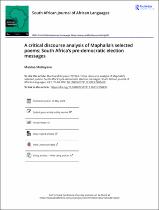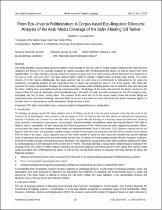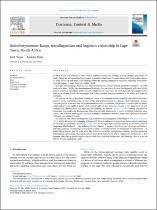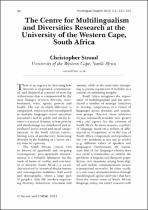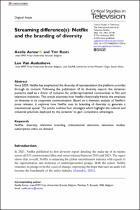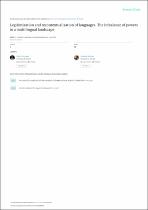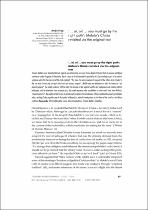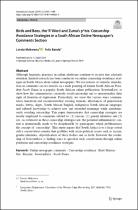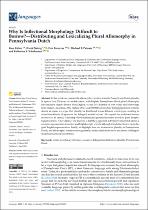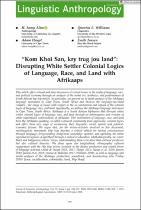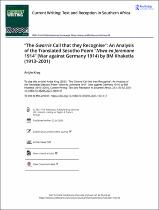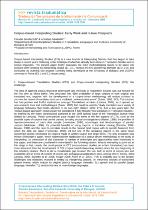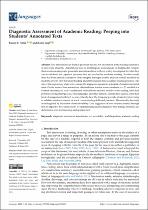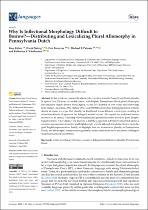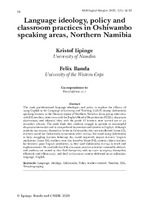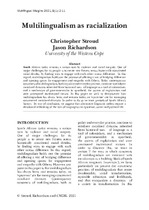Linguistics
Browse by
Recent Submissions
-
African moral theory and media ethics: An exploration of rulings by the South African press council 2018 to 2022
(Routledge, 2024)In light of a history of an unethical news media system used by the state as an instrument of oppression, media ethics in South Africa is intended to uphold the foundational tenets of journalism and play a pivotal role in ... -
School actors navigating between implementor & arbiter–a qualitative study on the dynamics in multilingual schools’ language policy
(Routledge, 2023)Over the past two decades, heightened migration has increased linguistic diversity in schools. For schools to cope with this multilingualism, many governments impose a monolingual policy where only the language of instruction ... -
Campus repertoires: interrogating semiotic assemblages, economy, and creativity
(De Gruyter Mouton, 2023)Framed within the broader theoretical context of social semiotics, we attempt to show how university students communicate using a variety of unique means, in particular social contexts. We privilege Pennycook and Otsuji’s ... -
-
A critical discourse analysis of maphalla’s selected poems: South Africa’s pre-democratic election messages
(Routledge, 2023)The years 1990 to 1994 were the most critical years in the lives of all South Africans. For writers, this period presented an opportunity for expressions that have long been suppressed due to the censoring of writers in ... -
From eco-jihad to politicization: A corpus-based eco-linguistic discourse analysis of the arab media coverage of the safer floating oil tanke
(Sciedu Press, 2023)This study attempts a corpus-based discourse analysis of the coverage of the FSO Safer in Arabic media to determine the main recurrent categories and themes in the coverage produced by outlets associated with conflicting/warring ... -
dalawhatyoumust: Kaaps, translingualism and linguistic citizenship in Cape Town, South Africa
(Discourse, Context & Media, 2023)In 2016 Wayde Van Niekerk, a South African athlete of mixed-race heritage won an Olympic gold medal. In South Africa, his win caused hashtags such as #proudlysouthafrican, #blackexcellence and #colouredexcellence to trend ... -
The centre for multilingualism and diversities research at the University of the Western Cape, South Africa
(University of the Western Cape, 2014)There is an urgency in theorising how diversity is negotiated, communicated, and disputed as a matter of everyday ordinariness that is compounded by the clear linkages between diversity, transformation, voice, agency, ... -
Streaming difference(s): Netflix and the branding of diversity
(SAGE Publications, 2023)Since 2020, Netflix has emphasised the diversity of representation the platform provides through its content. Following the publication of its diversity report, the streamer positions itself as a driver of inclusion for ... -
Legitimization and recontextualization of languages: The imbalance of powers in a multilingual landscape
(John Benjamins Publishing company, 2023)We use the uneven distribution of languages in the public spaces of the University of Zambia and the voices and narratives that emerge to argue for legitimization and recontextualization as critical components in the ... -
‘… Oi, oi! … you must go by the right path’: Mofolo’s Chaka revisited via the original text
(University of Pretoria, 2016)Thomas Mofolo never defended himself against accusations that his novel Chaka distorts historical facts to express anti-Nguni sentiments under the guise of Christianity. But in a way he foreshadowed the possibility of it, ... -
Birds and bees, the ‘r’ word and zuma’s p*nis: censorship avoidance strategies in a south african online newspaper’s comments section
(Springerlink, 2019)Although linguistic practices in online platforms continue to receive fair scholarly attention, limited research has been conducted on online censorship avoidance strategies in South Africa about online newspapers. We use ... -
Why is inflectional morphology difficult to borrow?—Distributing and lexicalizing plural allomorphy in Pennsylvania Dutch
(MDPI, 2022)In this article we examine the allomorphic variation found in Pennsylvania Dutch plurality. In spite of over 250 years of variable contact with English, Pennsylvania Dutch plural allomorphy has remained largely distinct ... -
“Kom Khoi San, kry trug jou land”: Disrupting White Settler Colonial Logics of Language, Race, and Land with Afrikaaps
(Wiley, 2021)This article offers a broad and deep discussion of critical issues in the study of language, race, and political economy through an analysis of the verbal art, aesthetics, and performances of South African hip hop artists. ... -
“The Gwarrie Call that they Recognise”: An analysis of the translated Sesotho poem “Ntwa ea Jeremane 1914” (War against Germany 1914) by BM Khaketla (1913–2001)
(Taylor and Francis, 2021)This essay looks at a recently translated poem, “Ntwa ea Jeremane 1914”, written by BM Khaketla, as a lens through which to approach the feelings and attitudes of people from Lesotho towards the world wars. A poem is ... -
Corpus-based interpreting studies: Early work and future prospects
(Frontiers Media S.A., 2022)This manuscript investigates to what extent the use of corpora could help translation trainees while translating from Arabic into English and vice versa. Forty Yemeni trainees, who were enrolled in an advanced course in ... -
Diagnostic assessment of academic reading: Peeping into students’ annotated texts
(MDPI, 2022)Text annotations are literacy practices that are not uncommon in the reading experience of university students. Annotations may be multilingual, monolingual, or multimodal. Despite their enormous diagnostic potentials, ... -
Why is inflectional morphology difficult to borrow?—Distributing and lexicalizing plural allomorphy in pennsylvania Dutch
(2021): In this article we examine the allomorphic variation found in Pennsylvania Dutch plurality. In spite of over 250 years of variable contact with English, Pennsylvania Dutch plural allomorphy has remained largely distinct ... -
Language ideology, policy and classroom practices in Oshiwambo speaking areas, Northern Namibia
(University of Western Cape, 2020)The study problematized language ideologies and policy to explore the efficacy of using English as the Language of Learning and Teaching (LOLT) among Oshiwambo speaking learners in the Omusati region of Northern ... -
Multilingualism as racialization
(University of Western Cape, 2021)South African today remains a nation torn by violence and racial inequity. One of major challenges for its people is to create new futures across historically constituted racial divides, by finding ways ...



